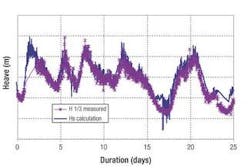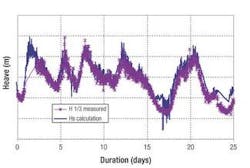Studies reveal extensive interaction among CALM buoys, mooring, export lines
Philippe Le Buhan
Principia
An offloading system using a single point mooring buoy and export lines is the basic solution adopted in current deepwater West Africa projects, including Girassol, Erha, Kizomba, and Bonga. A major topic in the design process, in addition to all the hydraulic/thermal issues, is prediction of fatigue life for both the mooring system and the export lines. The buoy motion is impacted greatly by the dynamic interaction of these lines, and therefore a coupled analysis is required.
For two years, a large number of experimental and numerical studies have been conducted for the coupled analysis, particularly by the Catenary Anchor Leg Mooring Buoy joint industry project (JIP) led by Principia in La Ciotat, France. Dedicated software tools now exist, but some uncertainties remain concerning the hydrodynamic and mechanical modeling aspects. However, the recent Girassol buoy instrumentation program in Angolan block 17 provided an opportunity to validate the JIP's results.
Coupled analysis, models
Due to the water depth and the size of the export lines, large coupled effects between the buoy motions and the dynamic lines govern the system:
- The mooring lines are partially taut, inducing a pitch-restoring load of the same order as the hydrostatic stiffness
- The export lines' weight imposes a non-symmetric mooring lines arrangement and tensions, in turn inducing mechanical coupling between the buoy degrees of freedom
- The buoy natural frequencies correspond to some export line modes in the wave frequencies range
- To reduce resonant motions, the buoy is generally equipped with horizontal skirts inducing a complex flow regime around the buoy. The challenge is to properly assess the corresponding hydrodynamic damping and added inertia on the buoy
- An additional problem is the influence of the offloading tanker, which is connected to the buoy at least 20% of the time. Mean and slow drift loads may induce modification of the mooring stiffness. In addition, the tanker's relative heading change increases the non-symmetric reaction of the offloading system.
Conventional station-keeping or mooring tools lack the required facilities to assess the main coupled effects. Several new tools have therefore been developed over the last few years, based on the following assumptions:
- The first and second order wave loads on the buoy are derived from classical diffraction analysis. Moonpool and skirt modeling could be quite difficult
- Drag loads and damping are derived from model tests or computational flow dynamics calculations. Additional added mass could be needed in heave and pitch due to vortex shedding at the skirt edges.
- Mooring and export lines are modeled using beam elements. Their dynamic responses are solved in time domain in a fully coupled system
- Response amplitude operators are derived in different ways from regular or irregular waves calculations using minimum/maximum approach, fast fourier transform or a cross-spectrum analysis.
- Damage is inferred from the wave scatter diagram and spectral shapes. An additional difficulty appears in the case of sea and swell conditions, as multiple-peaks and directional spectra are required.
On-site measurements
To investigate the behavior of the first deepwater offloading buoy ever installed, the Girassol project partners, led by Sonangol and Total, authorized instrumentation of the buoy, which comprised:
- Six degree-of-freedom motion sensors installed at the buoy turntable, and wave measurements 1 mi away
- Stress measurements on the upper steel oil offloading line (OOL) side developed by Cybernetix and Metravib.
null
Principia was commissioned to analyze the measured data obtained during a 30-day period, and to select typical samples for comparison and validation with global response given by numerical calculations tools with DeepLines (IFP/PRD software) and Diodore, calibrated in the Calm Buoy JIP. The following methodology was used in this process:
- The analytical shape of the wave spectra was fitted on the measurements
- The calculations were performed with a coupled model in time domain using the measured wave spectra for the OOL stress analysis, and a theoretical one for the buoy motions comparison
- Response amplitude operators were deduced from cross spectrum analysis, then used to estimate the root mean square distribution on the available overall measurement duration.
Motions and stresses obtained from both measurements and calculations were then compared. The buoy motions results show reasonably good agreement. In addition the in-situ motion measurements have clearly shown that coupling effects really are present. The measured heave motion periods are large and can be related to a steel export line mode.
Comparing the results to those from a decoupled method, the in-situ measurements confirm that coupled analysis is required and that the JIP's methodology is valid for estimating the buoy motions.
A second phase of the Calm Buoy JIP was recently launched by Principia to delve deeper into the previously listed topics and to derive guidelines for the fatigue analysis (mooring + OOL) of deepwater offloading systems, including mechanics and hydrodynamics features.
For more information, contact Philippe Le Buhan, manager of marine and offshore contract department, [email protected].

